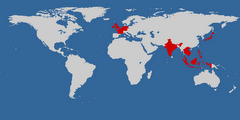Earlier this week I arrived safely in Kuching in Borneo after an easy flight and a reasonable in-flight meal. Once again I was relieved following touch down to find my luggage on the carousel, and an amenable immigration guard willing to let me in. Kuching is the starting point from which I will travel up Sarawak over the next few days until I reach Brunei.
I've found Kuching a pretty riverside city, which has warranted a fair bit of wandering round. British influence is very evident in this affluent and clean place. There are old colonial buildings, and British sounding street names (like Carpenter Street), and statues marking the long rule of the 'White Rajahs' (after helping quell a rebellion an Englishman called James Brooke was appointed hereditary Rajah of Sarawak in 1841, and his family ruled paternalistically on until 1946).
On Thursday I visited Fort Margherita, built by the Brooke's to protect Kuching from pirates, and found it something of a disappointment. A pretty white Victorian fort which has never been used in active combat, little has been made of it, and there was no-one around when I walked up - except for the waxwork guard on duty. On Friday I went to the Sarawak Museum and adjoining art gallery. Both are lovely and have absorbing and lively displays. Inside the main museum is amongst many other things the skeleton of a large whale, a reconstructed longhouse, and an exhibition on Shell Oil.
Saturday morning, as part of a tour with several other tourists, I went to the Semenggoh Orangutan Rehabilitation Centre, where twenty three native orangutans are being rehabilitated into the wild. Unfortunately the park keepers are doing such a good job that the apes didn't come out at feeding time and stayed in the wild of their reserve. I gazed into rainforest for nearly an hour and in the end only saw one rather large ant.
After we went on to an Iban longhouse. The Iban were the dreaded headhunters of Borneo* and now live as farmers and fisherman. For centuries they (and other local tribes) have lived in buildings known as a longhouses. The entire village community lives in a single dwelling which is built raised off the ground on stilts and divided into a public area along one side and a row of private living quarters along the other. It's hard for us Westerners to imagine such a style of living - it certainly felt very alien to me while I was there - but it seems to work well for the Iban of Borneo. It took several hours by mini-bus and a further hour by boat to reach the longhouse. Thirty five families live there and some have never left the village.
In the evening there was dancing and a rice whiskey drinking session in the public area. I drank my fair share and very much enjoyed it. Communication seemed to flow with the whiskey even though most of us could not speak each others languages. In the morning (we stayed overnight) we watched a cock fighting demonstration (minus the killer spikes) and then had a go shooting darts from Iban blow pipes. Blow pipes were once used to shoot poison tipped darts at enemies and hunted animals but today exist for tourists like me to fire into targets fixed to a post. I was pretty accurate and much more handy than I proved with an AK-47.
* The last Iban to cut someones head off as a trophy did so in 1970.

3 comments:
well good luck with your stay in singapore
I've found out where there are references and statues to cats all over Kuching. Kuching means 'Cat Town.'
Sorry 'why there' not 'where there.'
Post a Comment